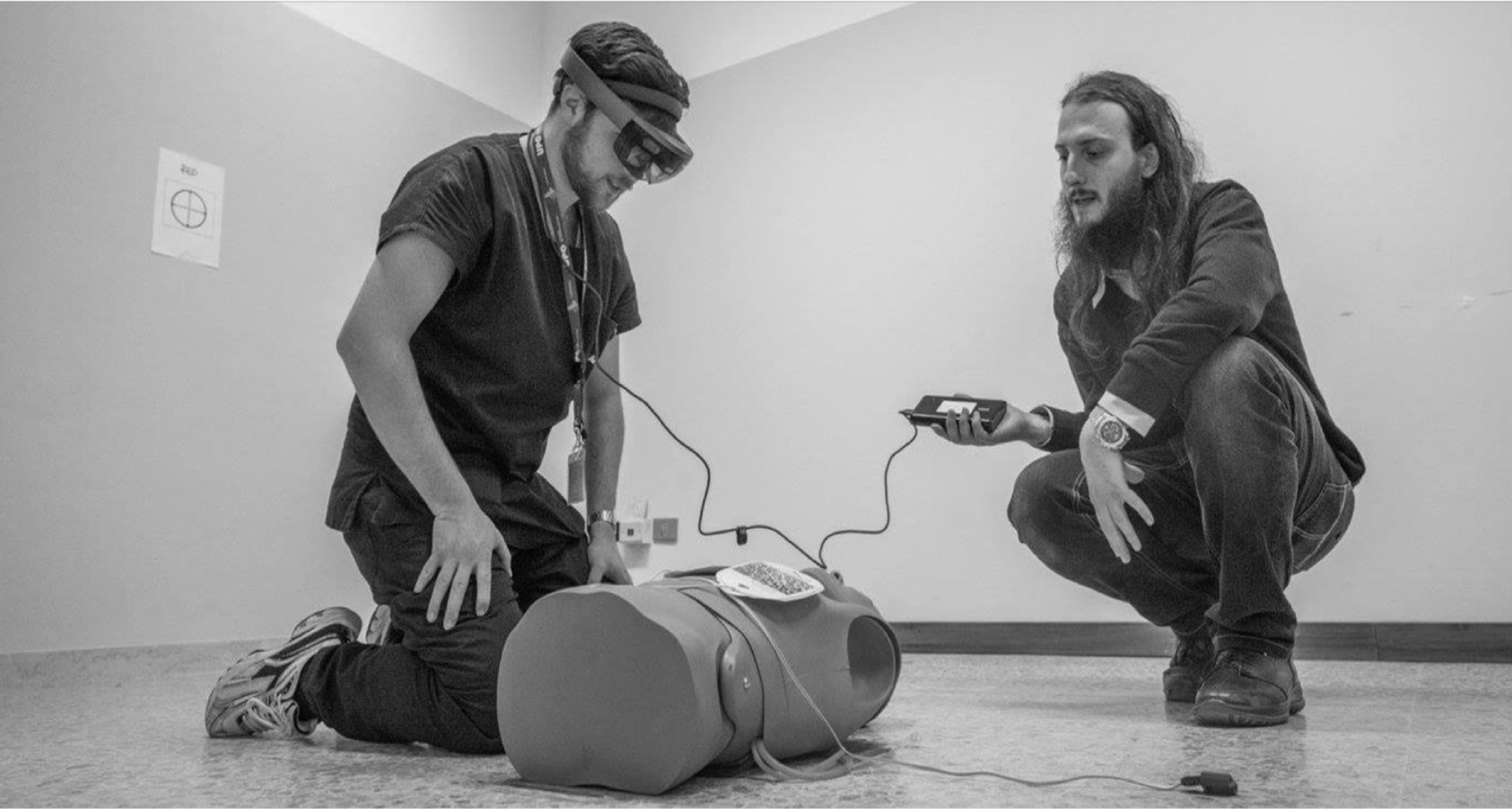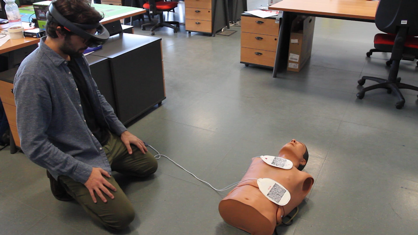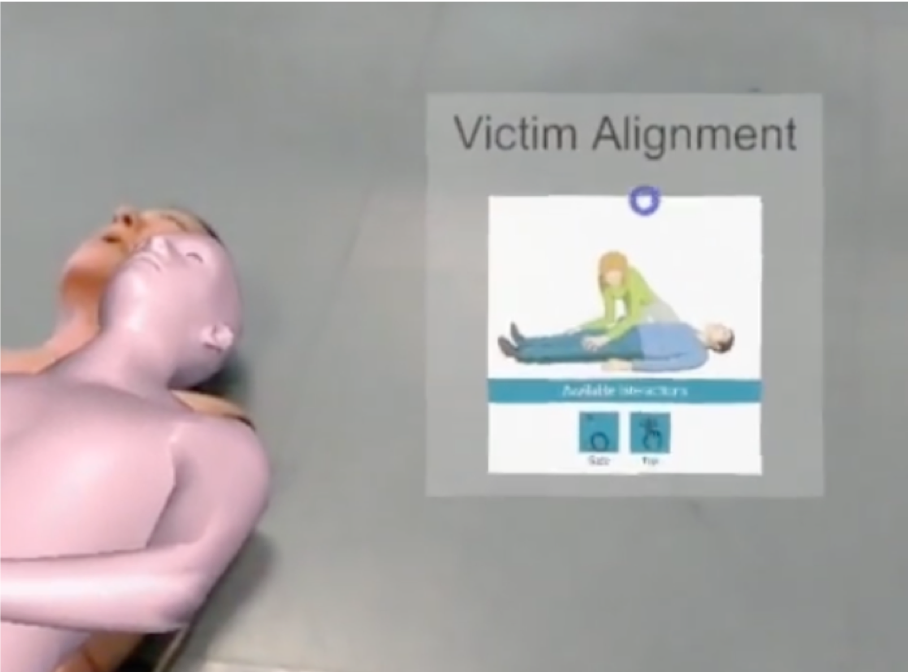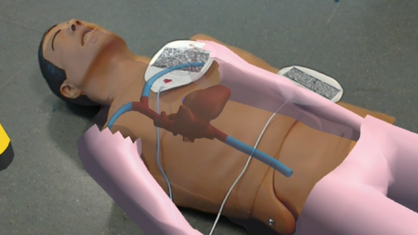
Easy and effective basic life support defibrillation training
Basic life support and defibrillation training made easy and effective by augmented reality and holograms! The solution designed by Logosnet, the Medical Simulation Center Simnova from the Eastern Piedmont University in Novara and the Polytechnic School of Turin was highly acclaimed in Los Angeles during the International Meeting of the Society for Simulation in Healthcare (SSIH-IMSH 2018), in Bilbao during the Annual Meeting of the European society for Simulation Applied to Medicine (SESAM 2018), and in New York during the International Conference on e-Learning in the Workplace held at Columbia University (ICELW 2018). Pier Luigi Ingrassia from Simnova and Fernando Salvetti from Logosnet were the speakers both in Los Angeles and in Bilbao, while in New York Fernando Salvetti was the unique speaker.
The solution
Providing an effective cognitive aid to both lay people and healthcare providers in Basic Life Support and Defibrillation (BLSD) procedures is a relevant educational goal in resuscitation.
A self-instruction learning simulation program was developed as a pilot project to maximize learning results, helping to enhance motor skills and the retention of cognitive knowledge, reducing instructor intervention and cost. Microsoft HoloLens technology was used, enabling users to interact with high definition holograms. Holo-BLSD was developed as a mixed reality self-instruction training environment allowing also assessment, using a standard low-cost manikin for cardio-pulmonary resuscitation (CPR) to deliver tactile information and haptic feedback. The manikin was “augmented” (AR) by an interactive virtual environment reproducing realistic scenarios. Learners used natural gestures, body movements and spoken commands to

Methods
Holo-BLSD is an interactive mixed-reality learning environment, providing learners with real-time feedback. In training mode, a self-instruction program is provided. After a short induction phase, users are guided through the sequence of actions required. Non-player characters (NPC) with different roles (by-standers, patient relatives, medical team members) deliver information or assist the trainee during the procedure. In evaluation mode, no guidelines are given, as the system only records and analyzes actions performed by the assessed trainee. Mixed reality techniques (MR) provide more interactivity and increase realism, by enriching the real world with digital information registered into the user’s perception of the environment.
In order to assess the prototypal system, we performed a qualitative evaluation with a user panel. At the end, participants were given a questionnaire asking them to rate a number of statements using a 5-point Likert scale (1: strongly disagree, 5: strongly agree).


Early Results
Our work is ongoing: 23 users (4 doctors and 19 residents) participated to the early experiments by testing the application once in training mode and filling the questionnaire. All of them had previous BLSD training and never (or rarely) used an AR application. Results showed a general appreciation of the system (average rate 4.7), which was found pleasant (4.1) and easy to use (4). The cognitive load required to operate the HoloLens was minimal (1.8): users could focus on the BLSD procedure and on carrying out actions requested. Voice (4.4) and gesture interaction (3.8) were evaluated positively, although some hand recognition errors reduced the feeling of having the right level of control over the system (3.4). Virtual contents were found realistic (3.8) and the reduced field of view of the HoloLens was not perceived as a severe limitation (1.3). Participants judged the system as capable to provide a real benefit as a training tool (4.2) and to help them to be more effective (4.2).
Maximizing learning results reducing the training costs
Our findings show that an interactive mixed reality learning environment could be an effective training tool for teaching BLSD procedures to both lay persons and healthcare providers. Holo-BLSD is a self-instruction learning program that requires minimal instructor intervention and, thus, can help to maximize learning results reducing the training cost. As major features, the system offers realistic haptic feedback through a CPR manikin and a virtual scenario that can be easily reconfigured to generate many different situations, including extreme and dangerous ones. All the data generated and the events occurring during the simulation (actions performed, NPC data, victim vital signs) are logged allowing instructors to immediately identify errors and difficulties of the trainees. Logging can also support an effective debriefing and, eventually, the creation of a library of training events.


